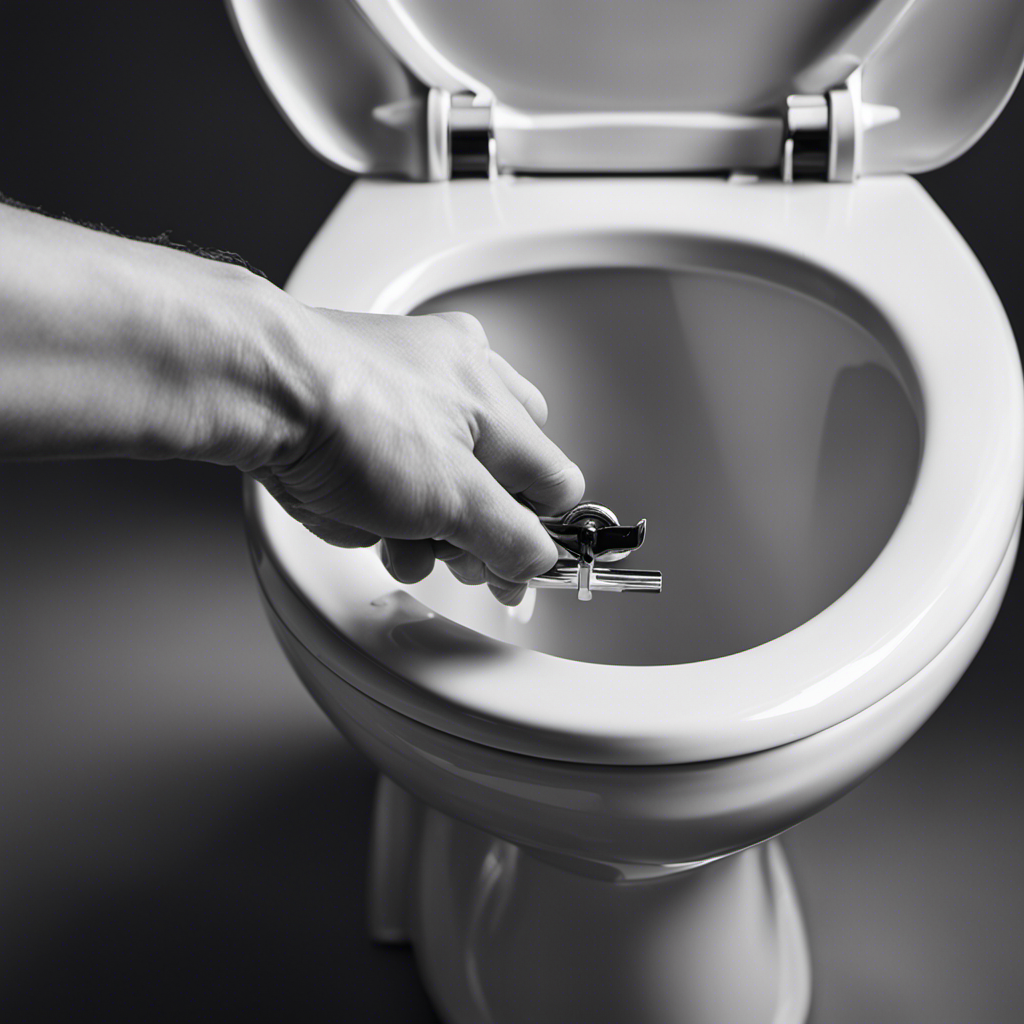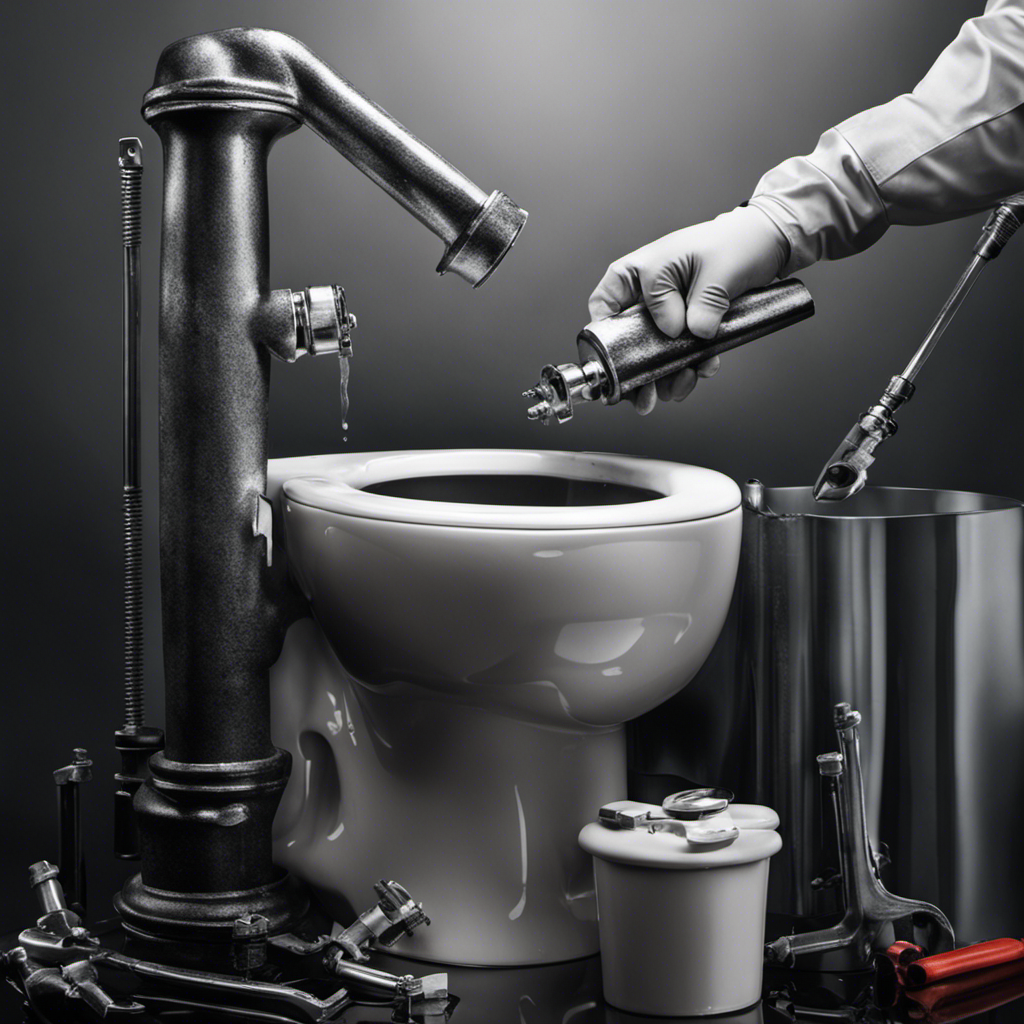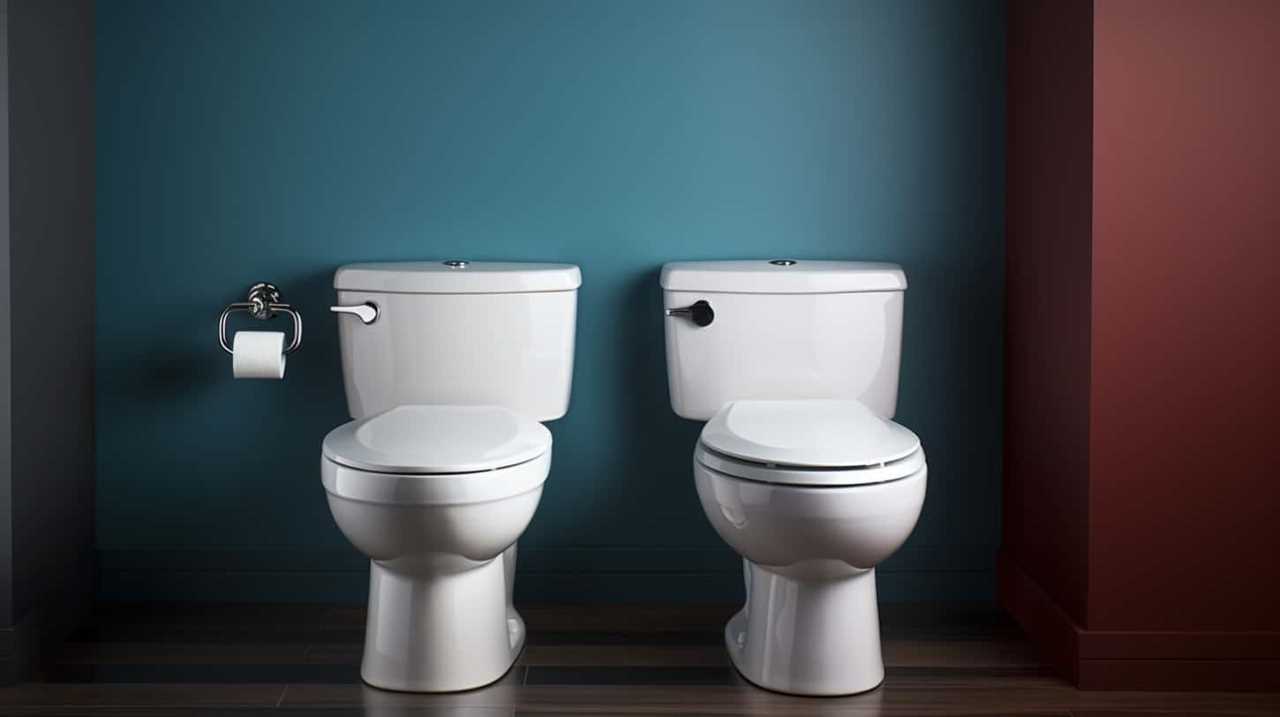Hey there! Ever been annoyed by a toilet handle that just sticks?
Well, I’ve got some good news for you – fixing it is easier than you might think!
In this article, I’m going to walk you through the step-by-step process of troubleshooting and repairing a stubborn toilet handle.
From identifying the problem to testing and troubleshooting, we’ll cover it all.
So grab your tools, roll up your sleeves, and let’s get to work fixing that sticking toilet handle once and for all!
Key Takeaways
- Sticking toilet handles are commonly caused by mineral deposits or loose connections.
- It is important to shut off the water supply before repairing a sticking toilet handle.
- The toilet handle chain should be properly adjusted to prevent disconnection or strain.
- Testing and troubleshooting techniques can help identify and fix issues with a sticking toilet handle.
Identifying the Problem
Toilet handles that stick are usually caused by a buildup of mineral deposits or a loose connection. Troubleshooting common issues with a sticking toilet handle involves understanding the toilet flushing mechanism.
When you press the handle, it lifts a chain or rod connected to the flapper valve at the bottom of the tank. This allows water to flow from the tank into the bowl, flushing away waste. However, if the handle sticks, it can prevent the flapper valve from fully opening or closing.
One common cause is mineral deposits, which can accumulate over time and cause the handle to stick. Another possibility is a loose connection between the handle and the flushing mechanism.
Tools and Materials Needed
You’ll need a few tools and materials to resolve the issue with a sticky handle. Here’s what you’ll need:
- Screwdriver: To remove the screws holding the toilet handle in place.
- Adjustable wrench: To loosen and tighten the nut that secures the handle to the toilet tank.
- Replacement toilet handle: Make sure to purchase one that matches the design and size of your current handle.
Troubleshooting toilet handle issues can be a straightforward process with the right tools. By following these steps, you’ll be able to replace your sticky toilet handle and restore its functionality.
Once you have gathered the necessary tools and materials, you can proceed to the next step: shutting off the water supply. This will ensure a safe and dry working environment as you continue with the repair process.
Shutting Off the Water Supply
Once you’ve gathered the necessary tools and materials, it’s important to shut off the water supply before proceeding. This step is crucial to ensure a safe and effective repair.
To begin, locate the water shut-off valve, which is usually located on the wall behind the toilet. Turn the valve clockwise until it is fully closed. This will stop the flow of water to the toilet and prevent any potential leaks or accidents.
With the water supply shut off, you can now proceed with replacing the toilet flapper or adjusting the float level. Remember to follow the manufacturer’s instructions carefully and take your time to ensure a proper repair.
Once the repair is complete, don’t forget to turn the water supply back on by turning the valve counterclockwise.
Removing the Toilet Tank Lid
After shutting off the water supply, start by carefully removing the toilet tank lid. This is an important step when replacing the flushing mechanism or cleaning the toilet tank. Here’s how to do it:
- Locate the two screws on the bottom of the tank. These screws secure the lid to the tank.
- Use a screwdriver to loosen and remove the screws. Place them in a safe spot to avoid losing them.
Once the screws are removed, lift the lid straight up. Be careful as it may be heavy or fragile. Set the lid aside in a safe place where it won’t be damaged.
With the lid removed, you now have access to the inner workings of the toilet tank. Take this opportunity to inspect the flushing mechanism for any signs of damage or wear. If you are replacing the flushing mechanism, follow the manufacturer’s instructions for removal and installation.
Additionally, while the tank is open, it’s a good idea to clean it thoroughly to remove any buildup or debris. Use a sponge or scrub brush to clean the walls and bottom of the tank. Rinse the tank well to remove any cleaning residue before proceeding with any repairs or replacements.
Adjusting the Toilet Handle Chain
To adjust the toilet handle chain, start by identifying the point where the chain connects to the flushing mechanism. This connection point is usually a small metal or plastic hook. Once you have located it, you can proceed with making the necessary adjustments.
One common issue with toilet handle chains is that they can become stuck or difficult to move. To fix this, try lubricating the handle mechanism with some WD-40 or a similar lubricant. Apply the lubricant to the moving parts of the handle mechanism and work it in by moving the handle back and forth a few times.
If the chain is too loose or too tight, you can adjust the tension by either lengthening or shortening the chain. This can be done by either adding or removing links from the chain. Just make sure that the chain is not too loose to the point where it becomes disconnected from the flushing mechanism, or too tight that it puts unnecessary strain on the handle.
Replacing the Toilet Handle
When replacing the toilet handle, it’s important to choose a handle that matches the style and design of your toilet. This ensures a cohesive look and avoids any aesthetic inconsistencies. However, it’s not just about appearance; the handle also needs to function properly.
Here are some common toilet handle problems and how to repair them:
-
Loose handle: If the handle feels wobbly or doesn’t stay in place, it could be due to a loose attachment. Tighten the mounting nut or replace it if necessary.
-
Sticking handle: If the handle sticks or is hard to push down, it may be due to mineral buildup or a faulty mechanism. Clean the handle and the inside of the tank, or replace the entire handle assembly.
-
Broken handle: If the handle is completely broken, it’s time for a replacement. Remove the old handle by unscrewing the mounting nut, then install the new handle according to the manufacturer’s instructions.
Testing and Troubleshooting
Now that I’ve replaced the toilet handle, it’s time to test and troubleshoot any issues that may arise.
Testing techniques are essential to ensure that the new handle is working properly and doesn’t stick.
One common issue is the handle not responding when flushed. To troubleshoot this, I would start by checking if the chain is properly connected and not tangled. Adjusting the chain length may also be necessary.
Another common issue is the handle sticking in the down position, causing the toilet to continuously flush. This can be fixed by adjusting the lift arm or replacing the flapper.
Lastly, if the handle feels loose or wobbly, tightening the mounting nut should solve the problem.
Frequently Asked Questions
How Do I Know if My Toilet Handle Is Sticking?
I know my toilet handle is sticking when it doesn’t return to its original position after flushing. It’s a common issue caused by loose or worn parts. I’ll show you how to fix it quickly.
Can I Fix a Sticking Toilet Handle Without Shutting off the Water Supply?
I can fix a sticking toilet handle without shutting off the water. There are alternatives to shutting off the water when fixing the handle. Let me share some practical tips and detailed steps with you.
What if I Don’t Have Any of the Tools and Materials Mentioned?
If I don’t have the tools and materials mentioned, there are still alternative solutions. I could try improvising tools like a wire hanger or a zip tie to fix the sticking toilet handle.
Is It Necessary to Remove the Toilet Tank Lid to Fix a Sticking Handle?
No, it is not necessary to remove the toilet tank lid to fix a sticking handle. There are alternative solutions to fix a sticking toilet handle without removing the tank lid. Common causes of a sticking toilet handle include…
Can I Replace the Toilet Handle With a Different Style or Design?
Can I replace the toilet handle with a different style or design? Considering toilet handle alternatives, it’s possible to find various options that suit your preferences. However, it’s important to weigh the pros and cons before making a decision.
Conclusion
In conclusion, fixing a toilet handle that sticks is a simple and practical task that anyone can do. By following the steps outlined in this article, you can easily identify and resolve the problem.
With just a few tools and materials, and a little bit of time, you can have your toilet handle working smoothly again. Remember to shut off the water supply, adjust the chain, or replace the handle if necessary.
Test your fix and troubleshoot any issues that may arise. Now go forth and conquer that sticky toilet handle!









